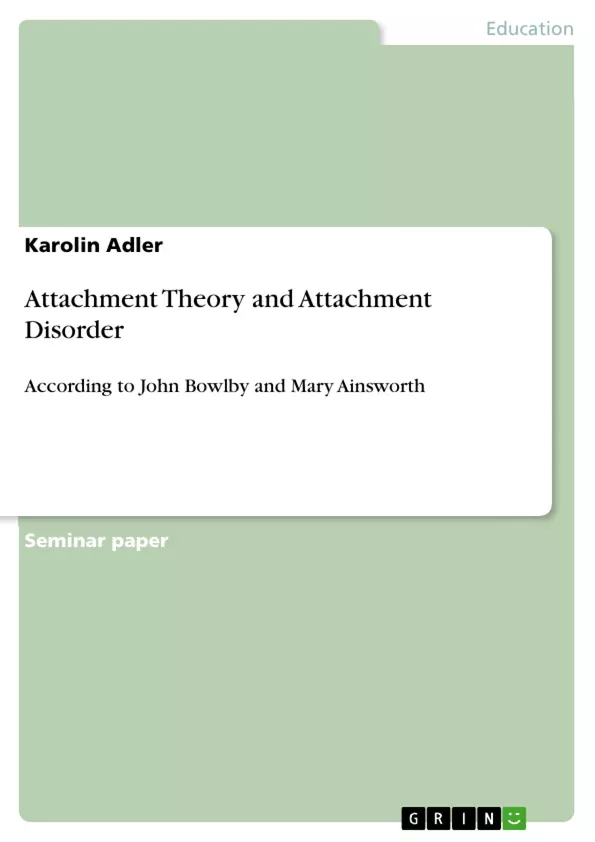Humans are social beings and cannot live without interpersonal contact. Such bonds already develop during pregnancy and are decisively shaped here by the mother's feelings. The mother's attitude towards the child growing in the womb is decisive for later behaviour. The nature of the emotional and affective experiences in early childhood determine whether a child will develop a sense of basic trust or basic mistrust. The newborn can only perceive its caregiver through the senses of smell and touch (physical contact), i.e. through smelling, tasting and feeling. The emotional attention creates an atmosphere of security in the child. This atmosphere contains the generated self-confidence, the trust in fellow human beings and the environment. This is also necessary to muster the courage to take on new, unknown things. The basic trust is therefore a positive attitude towards oneself, based on earlier experiences - also in the womb - and it enables people to deal constructively with their environment and themselves. Not only environmental factors but also genetic influences play a major role in the personality development of the individual. A person's mental state is strongly dependent on how his or her interpersonal relationships are. If they are harmonious, there is a high probability that this person will be balanced and happy and able to cope with problems as they arise.
The emotional foundation comes from sufficient emotional attention. Through it, the social courage to face life is formed, which is of high importance for the child's mental, social and emotional development. If one cannot rely on one's attachment figures, social pessimism is generated, which can have an inhibiting effect on the child's emotional development. One subject of attachment research is the development and change of close relationships in the course of life. In my term paper, I would like to discuss the strong bond between child and caregiver and try to explain it in more detail using John Bowlby's attachment theory. Then I will discuss attachment disorders and the types of attachment disorders, and at the end I will try to critically examine the attachment theory.
Table of Contents
- Introduction.
- John Bowlby and the origins of attachment theory
- Fundamentals of attachment theory
- Definition of the term "attachment"
- Characteristics of attachment behaviour
- Inner working models
- Sensitivity
- Secure basis.
- The Strange Situation according to Mary Ainsworth.
- Patterns of attachment behaviour
- Category B: Securely attached children.
- Category A: Insecure-avoidant attached children
- Category C: Insecure-ambivalently attached children.
- Category D: Children with insecure disorganized/disoriented behavioral patterns
- Attachment representation
- Forms of attachment representation
- Other factors for attachment security.
- Patterns of attachment behaviour
- Unfavorable attachment experiences and later psychopathology
- Attachment disorder
- Types of attachment disorders in childhood
- Criticism of attachment theory.
- Origin and background of attachment quality
- Continuity assumption
- "Strange situation" (laboratory situation).
- Attachment Hierarchy.
Objectives and Key Themes
This term paper aims to explore the concept of attachment and its significance in human development. It will delve into the origins of attachment theory, focusing on the contributions of John Bowlby and Mary Ainsworth. The paper will then discuss the fundamentals of attachment theory, examining key concepts such as the definition of "attachment", characteristics of attachment behavior, inner working models, sensitivity, and secure base.
- The origins and development of attachment theory
- Key concepts within attachment theory, such as sensitivity and secure base
- The impact of attachment on individual development and psychopathology
- Critical perspectives on attachment theory
- The role of attachment in the development of close relationships
Chapter Summaries
The first chapter introduces the concept of attachment and its importance in human development. It emphasizes the significance of emotional attention and basic trust in building healthy relationships. The second chapter delves into the origins of attachment theory, focusing on the work of John Bowlby and his key contributions. It highlights Bowlby's research on the impact of early childhood deprivation and his efforts to bridge developmental psychology, psychoanalysis, and evolutionary biology. The chapter also explores the contributions of Mary Ainsworth and her role in expanding attachment theory. The third chapter presents the fundamentals of attachment theory, discussing key concepts such as "attachment", attachment behavior, inner working models, sensitivity, and secure base. It provides a comprehensive overview of these concepts to facilitate a deeper understanding of attachment theory.
Keywords
The main keywords and focus topics of this paper are attachment, attachment theory, John Bowlby, Mary Ainsworth, sensitivity, secure base, inner working models, attachment behavior, attachment disorders, and critical perspectives on attachment theory. These terms represent the core concepts and themes explored throughout the work, offering a concise overview of its key focus areas.
- Citation du texte
- Karolin Adler (Auteur), 2011, Attachment Theory and Attachment Disorder, Munich, GRIN Verlag, https://www.grin.com/document/1176337



